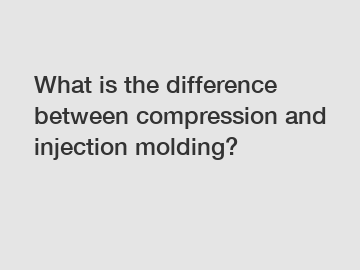What is the difference between compression and injection molding?
What is the difference between compression and injection molding?
Compression molding and injection molding are two commonly used methods for manufacturing plastic components. While both processes involve molding plastic materials, there are distinct differences between the two.
Compression molding is a manufacturing process where a pre-measured amount of heated polymer material is placed into a mold cavity. The mold is then closed, and pressure is applied to the material to allow it to take the shape of the mold. The pressure is maintained until the material has hardened and is ready to be removed from the mold. This process is commonly used for larger, thicker parts with lower production volumes.

On the other hand, injection molding involves injecting molten plastic material into a mold cavity at high pressure. The mold is kept closed until the material cools and solidifies. This process is ideal for producing smaller, intricate parts with high production volumes.
The difference between compression molding and injection molding lies in the fundamental way the materials are introduced into the mold. In compression molding, the heated polymer material is pre-measured and pre-shaped before being placed into the mold. The pressure is then applied to shape the material. In contrast, injection molding injects molten material directly into the mold cavity under high pressure.
The choice between compression molding and injection molding depends on various factors, including the size and complexity of the part, the required production volume, and the desired properties of the final product. Compression molding is generally considered more suitable for larger parts with lower production volumes, as it allows for more flexibility in material selection and the ability to incorporate inserts or multiple materials into the mold. Injection molding, on the other hand, is better suited for high-volume production of smaller, more intricate parts. It offers faster cycle times, higher production rates, and tighter tolerances.
The selection of the appropriate molding process is crucial as it directly impacts the quality, cost, and time of production. Compression molding may require more initial setup and preparation time due to the manual handling of the material and molds. However, it offers greater flexibility and versatility compared to injection molding. Injection molding, while more automated and efficient, may require higher upfront tooling and equipment costs.
In conclusion, the difference between compression molding and injection molding lies in the method of introducing the material into the mold. Both processes have their advantages and disadvantages, and the choice depends on various factors. Understanding these differences allows manufacturers to select the most suitable molding process for their specific needs, ensuring optimal manufacturing outcomes.
Are you interested in learning more about dispensing closure, dispensing closure, dispensing closure? Contact us today to secure an expert consultation!
151
0
0


Comments
All Comments (0)